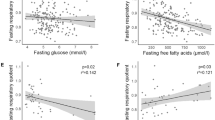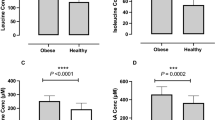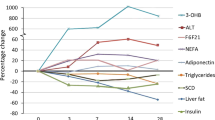Abstract
BACKGROUND:
Glycemic index is hypothesized to determine fuel partitioning through serum plasma insulin modifications induced by dietary carbohydrates, thereby modulating fat accretion or oxidation.
OBJECTIVE:
To assess the glycemic effects on postprandial fuel oxidation and blood response.
DESIGN:
In all, 12 obese women were fed on a randomized crossover design with two test meals (breakfast+lunch). High- or low-glycemic meals were provided on separate days. Energy intake on high-glycemic meal was 7758±148 kJ and for low-glycemic meal was 7806±179 kJ. Carbohydrates supplied were 273±5 and 275±6 g, respectively. Macronutrient distribution was 55% carbohydrates, 30% fat and 15% protein. Fuel oxidation was measured continuously in a respiratory chamber for 10 h. Serum glucose, free fatty acids (FFA), insulin and glucagon samples were taken for 5 h after breakfast.
RESULTS:
Glucose AUC changed significantly in response to different glycemic breakfast. Low- vs high-glycemic breakfast was 211±84 and 379±164 mmol/l (P<0.05). Similarly, insulin changed from 94±37 and 170±87 nmol/l (P<0.05), respectively. The rate of increment for serum glucose and insulin reached by the high- vs low-glycemic meal was 1.8 times more with the high-glycemic breakfast. Serum FFA were similarly suppressed by both meal types by 3 h after meal intake, but then raised significantly more with the low-glycemic meal by the fourth and fifth hour (P<0.05). Plasma glucagon did not show a significant variation with glycemic index. Carbohydrate and fat oxidation was not modified by glycemic meal characteristics, being virtually the same for low- vs high-glycemic comparisons in the 5 h following breakfast and lunch (P=NS).
CONCLUSION:
This study demonstrates that dietary glycemic characteristics were unable to modify fuel partitioning in sedentary obese women.
This is a preview of subscription content, access via your institution
Access options
Subscribe to this journal
Receive 12 print issues and online access
$259.00 per year
only $21.58 per issue
Buy this article
- Purchase on Springer Link
- Instant access to full article PDF
Prices may be subject to local taxes which are calculated during checkout


Similar content being viewed by others
References
World Health Organization. Report of a WHO consultation on obesity. Geneva, Italy, WHO/NUT/NCD/98.1. 1998.
Jenkins D, Wolever T, Taylor R, Barker H, Fielden H, Baldwin J, Bowling A, Newman H, Jenkins A, Goff D . Glycemic index of foods: a physiological basis for carbohydrate exchange. Am J Clin Nutr 1981; 34: 362–366.
Food and Agriculture Organization. Carbohydrates in human nutrition: a summary of the joint FAO/WHO expert consultation. Rome, Italy; 1997.
Brand-Miller J, Holt S, Pawlak D, McMillan J . Glycemic index and obesity. Am J Clin Nutr 2002; 76 (suppl): 281S–285S.
Ludwig D . The glycemic index: physiological mechanisms relating to obesity, diabetes, and cardiovascular disease. JAMA 2002; 287 (18): 2414–2423.
Willet W, Manson J, Liu S . Glycemic index, glycemic load, and risk of type 2 diabetes. Am J Clin Nutr 2002; 76 (suppl): 274S–280S.
Jenkins D, Kendall C, Augustin L, Franceschi S, Hamidi M, Marchie A, Jenkins A, Axelsen M . Glycemic index: overview of implications in health and disease. Am J Clin Nutr 2002; 76 (suppl): 266S–273S.
Sparti A, Milon H, Di Vetta V, Schnetter P, Tappy L, Jéquier E, Schutz Y . Effect of diets high or low in unavailable and slowly digestible carbohydrates on the pattern of 24-h substrate oxidation and feelings of hunger in humans. Am J Clin Nutr 2000; 72: 1461–1468.
Howe J, Rumpler W, Behall K . Dietary starch composition and level of energy intake alter nutrient oxidation in ‘carbohydrate sensitive’ men. J Nutr 1996; 126: 2120–2129.
McDevitt R, Poppitt S, Murgatroyd P, Prentice A . Macronutrient disposal during controlled overfeeding with glucose, fructose, sucrose, or fat in lean and obese women. Am J Clin Nutr 2000; 72: 369–377.
Report of the expert committee on the diagnosis and classification of diabetes mellitus. Diabetes Care 2003; 26 (suppl 1): S5–S20.
Summary of the second report of the National Cholesterol Education Program (NCEP). Expert panel on detection, evaluation, and treatment of high blood cholesterol in adults (Adult Treatment Panel II). JAMA 1993; 269: 3015–3028.
Schmidt-Hebbel H, Pennacchiotti I, Masson L, Mella MA . Tabla de composición de los alimentos Chilenos, 8th ed. Facultad de Química y Farmacia. Universidad de Chile 1992.
Schofield W . Predicting basal metabolic rate, new standards and review of previous work. Hum Nutr Clin Nutr 1985; 39C (suppl 1): 5–41.
Siri WE . The gross composition of the body. Adv Biol Med Physiol 1956; 4: 239–280.
Livesey G, Elia M . Estimation of energy expenditure, net carbohydrate utilization, and net fat oxidation and synthesis by indirect calorimetry: evaluation of errors with special reference to the detailed composition of fuels. Am J Clin Nutr 1988; 47: 608–628.
Murgatroyd P, Sonko B, Wittekind A, Goldberg G, Ceesay S, Prentice A . Non-invasive techniques for assessing carbohydrate flux: I. Measurement of depletion by indirect calorimetry. Acta Physiol Scand 1993; 147: 91–98.
Wolever T, Jenkins D . The use of the glycemic index in predicting the blood glucose response to mixed meals. Am J Clin Nutr 1986; 43: 167–172.
Waterhouse C, Baker N, Rostami H . Effect of glucose ingestion on the metabolism of free fatty acids in human subjects. J Lipid Res 1969; 10: 487–494.
Bonadonna R, Groop L, Zych K, Shank M, DeFronzo R . Dose-dependent effect of insulin on plasma FFA turnover and oxidation in humans. Am J Physiol (Endocrinol Metab) 1990; 259: E736–E750.
Campbell P, Carlson M, Nurjhan N . Fat metabolism in human obesity. Am J Physiol (Endocrinol Metab) 1994; 266: E600–E605.
Thiebaud D, Jacot E, DeFronzo R, Maeder E, Jequier E, Felber JP . The effect of graded doses of insulin on total glucose uptake, glucose oxidation, and glucose storage in man. Diabetes 1982; 31: 957–963.
Blaak E, Saris W . Postprandial thermogenesis and substrate utilization after ingestion of different dietary carbohydrates. Metabolism 1996; 45: 1235–1242.
Ritz P, Krempf M, Cloarec D, Champ M, Charbonnel B . Comparative continuous-indirect-calorimetry study of two carbohydrates with different glycemic indices. Am J Clin Nutr 1991; 54: 855–859.
Delarue J, Couet C, Cohen R, Brechot JF, Antoine JM, Lamisse F . Effects of fish oil on metabolic responses to oral fructose and glucose loads in healthy humans. Am J Physiol 1996; 270 (Endocrinol Metab 33): E353–E362.
Wolever T, Bentum-Williams A, Jenkins D . Physiological modulation of plasma free fatty acid concentration by diet. Diabetes Care 1995; 18 (7): 962–970.
Bouche C, Rizkalla S, Luo J, Vidal H, Veronese A, Patcher N, Fouqett C, Lang V, Slama G . Five week, low-glycemic index diet decreases total fat mass and improves plasma lipid profile in moderately overweight nondiabetic men. Diabetes Care 2002; 25: 822–828.
Ludwig D, Majzoub J, Al-Zahrani A, Dallal G, Blanco I, Roberts S . High glycemic index foods, overeating and obesity. Pediatrics 1999; 103: 26–31.
Jarvi A, Karlström B, Granfeldt Y, Björck I, Asp NG, Vessby B . Improved glycemic control and lipid profile and normalized fibrinolytic activity on a low-glycemic index diet in type 2 diabetic patients. Diabetes Care 1999; 22: 10–18.
Ball S, Keller K, Moyer-Mileur L, Ding YW, Donaldson D, Jackson D . Prolongation of satiety after load versus moderately high glycemic index meals in obese adolescents. Pediatrics 2003; 111 (3): 488–494.
Elliot S, Keim N, Stern J, Teff K, Havel P . Fructose, weight gain, and the insulin resistance syndrome. Am J Clin Nutr 2002; 76: 911–922.
Karpe F, Olivecrona T, Olivecrona G, Samra J, Summers L, Humphreys S, Frayn K . Lipoprotein lipase transport in plasma: role of muscle and adipose tissues in regulation of plasma lipoprotein lipase concentration. J Lipid Res 1998; 39: 2387–2393.
Fielding B, Frayn K . Lipoprotein lipase and the disposition of dietary fatty acids. Br J Nutr 1998; 80: 495–502.
Acknowledgements
We want to thank Dr Carmen Romero, Mr Manuel Maliqueo and Mr Claudio Lartiga for their technical assistance in performing laboratory analyses. We wish to thank Ingrid Rodríguez, Angélica Letelier and Jorge Inostroza for their collaboration in this study. Dr Peter Murgatroyd is particularly acknowledged for his support in setting-up the respiratory chamber and his valuable scientific advice. Finally, our volunteers are specially acknowledged for their interest, time and cooperation. Supported by Fondecyt-Conicyt project N° 1010559.
Author information
Authors and Affiliations
Corresponding author
Rights and permissions
About this article
Cite this article
Díaz, E., Galgani, J., Aguirre, C. et al. Effect of glycemic index on whole-body substrate oxidation in obese women. Int J Obes 29, 108–114 (2005). https://doi.org/10.1038/sj.ijo.0802592
Received:
Revised:
Accepted:
Published:
Issue Date:
DOI: https://doi.org/10.1038/sj.ijo.0802592
Keywords
This article is cited by
-
Does the ingestion of a 24 hour low glycaemic index Asian mixed meal diet improve glycaemic response and promote fat oxidation? A controlled, randomized cross-over study
Nutrition Journal (2017)
-
Effect of low-glycemic-sugar-sweetened beverages on glucose metabolism and macronutrient oxidation in healthy men
International Journal of Obesity (2016)
-
Carbohydrate intake and glycemic index affect substrate oxidation during a controlled weight cycle in healthy men
European Journal of Clinical Nutrition (2014)
-
Effect of breakfast glycemic index on metabolic responses during rest and exercise in overweight and non-overweight adolescent girls
European Journal of Clinical Nutrition (2012)
-
No effect of a diet with a reduced glycaemic index on satiety, energy intake and body weight in overweight and obese women
International Journal of Obesity (2008)



